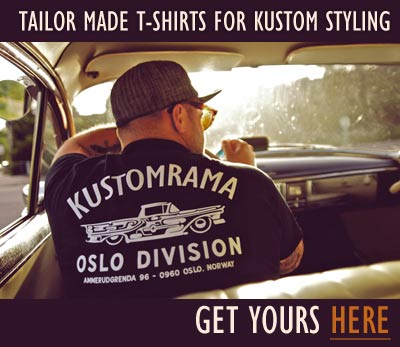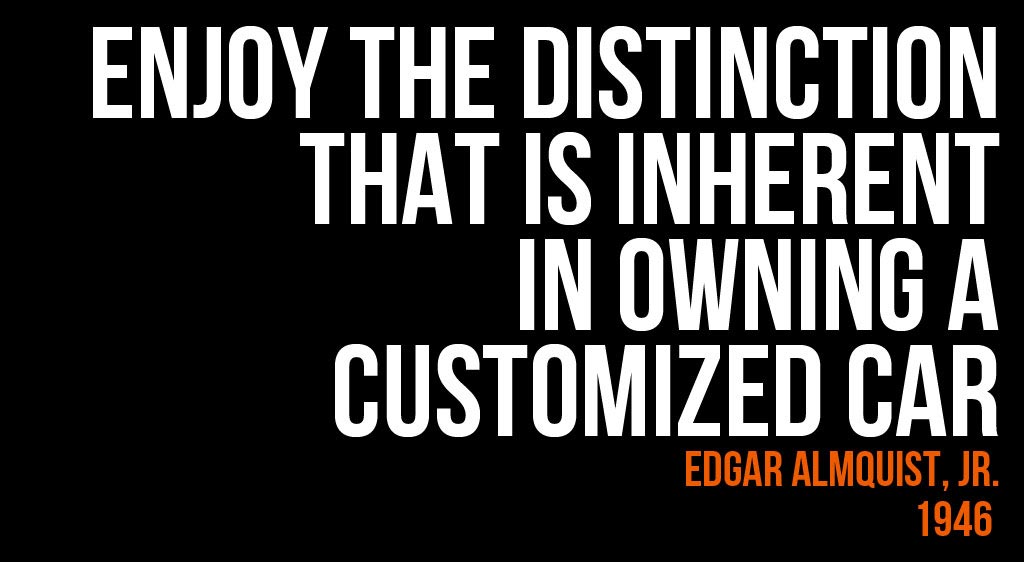Jimmy Summers
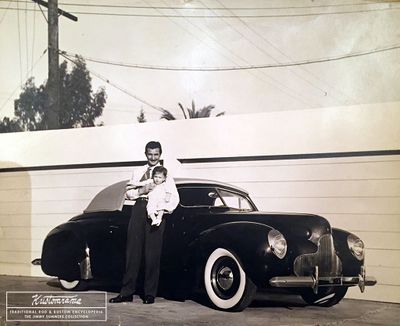
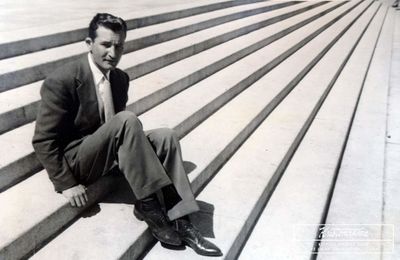
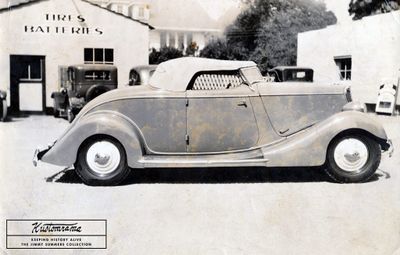






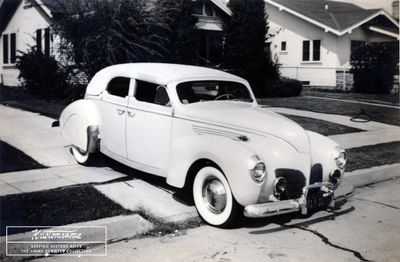
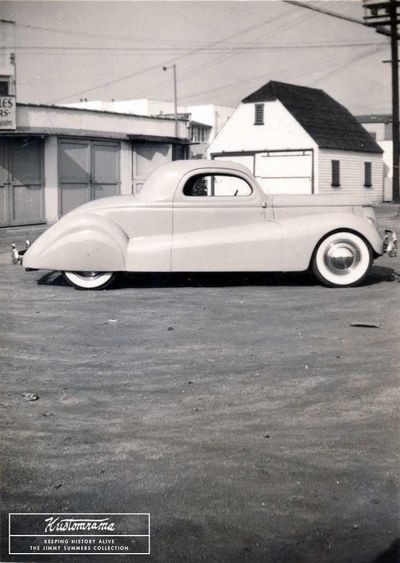
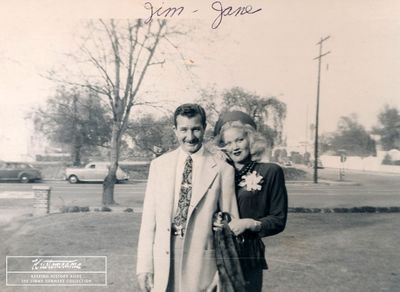
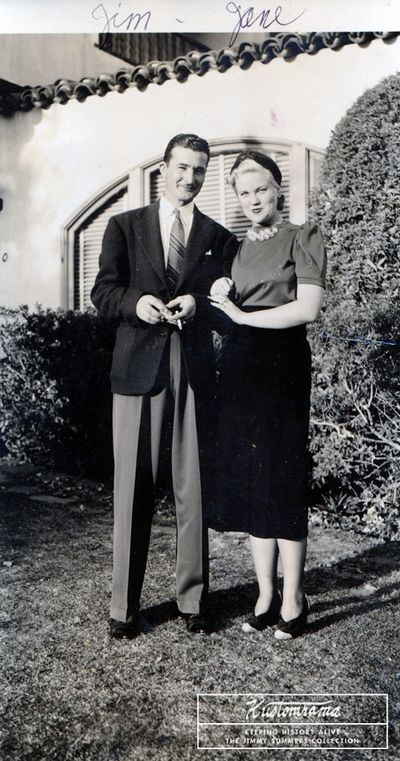

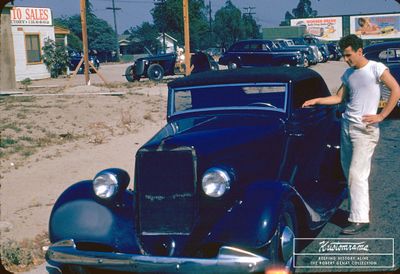

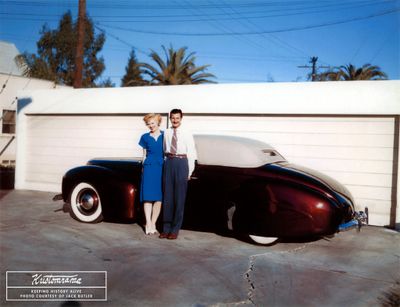



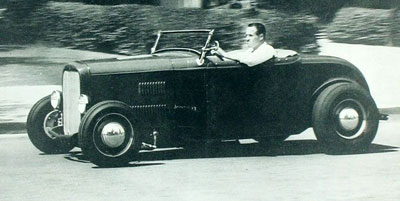
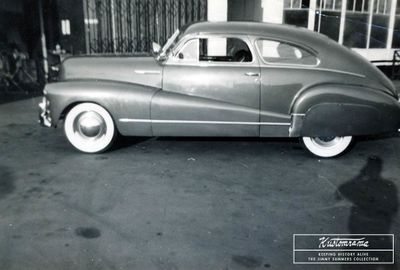


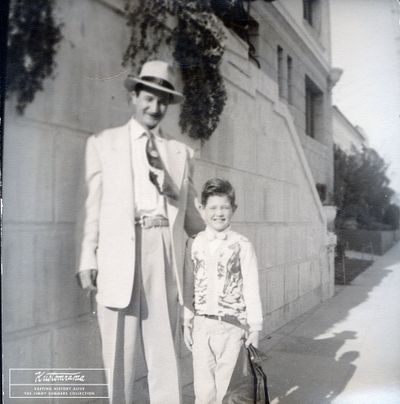


James Merlin Traft Summers (September 22, 1913 - October 24, 1968) was one of the most popular pre-war customizers in Southern California. There were several "custom body" shops in the Los Angeles area dating back to the 1920s, such as Bohman and Schwartz, Coachcraft, and Don Lee Body Works, but two of the first to specialize in customizing based on base-line production cars were Jimmy Summers and Roy Hagy.[1] Ed Iskenderian and Alex Xydias remember Summers as the most popular pre-war customizer in Southern California. Dan Post believes he might have been the first one. Summers had been restyling cars for nearly two decades when Robert E. Petersen launched Hot Rod Magazine in January of 1948.
Contents
- 1 Born in Montana
- 2 Jim Was Very Intelligent - "He Could Use Both Sides of the Brain"
- 3 A New Life in California
- 4 Carpetbaggers
- 5 Custom Pioneer
- 6 Ed Iskenderian's 1924 Ford Model T Roadster
- 7 Tom Sparks
- 8 Barbells
- 9 Alex Xydias' 1934 Ford Cabriolet
- 10 Jimmy Summers' 1932 Ford Roadster
- 11 Jimmy Summers' 1940 Mercury
- 12 Summers Fender Extension
- 13 One car a week
- 14 The Bill Hughes' Roadster
- 15 The 1939 Coachcraft Mercury Roadster
- 16 The father of the channel job?
- 17 Jimmy the Entrepreneur
- 18 First marriage
- 19 Tony Nancy's Dragster
- 20 Jimmy passes away
- 21 Jimmy Summers' personal rides
- 22 Cars restyled by Jimmy Summers
- 23 People working for Jimmy Summers
- 24 References
Born in Montana
"Dad was the third of seven siblings," Lee Summers told Sondre Kvipt of Kustomrama in 2019 when he was working on a story about Summers for The Rodder's Journal and Kustomrama.[2] Jim was born on September 22, 1913, in Lewistown, Montana. "Everyone called him Jimmy. At home, he was Jim or dad," Lee's stepsister Kris told Sondre during the interview.[3]
Jim Was Very Intelligent - "He Could Use Both Sides of the Brain"
Jim's parents, Jack and Virna, came from Texas. His father was a farmer, and Jim grew up on a cattle ranch in Roy, Montana. "He didn't like that life at all," Kris' sister Karen told Sondre. "He didn't like the cold, and he didn't like riding horses." Jim was very intelligent, and he graduated high school when he was 14. "He could use both sides of the brain," Karen explained. "Most people just use one or the other. He could do two things at the same time. He could be drawing and doing math at the same time - Using each hand!"[4]
A New Life in California
After Jim graduated, the Summers moved out West, settling down in West Salem, Oregon. Jim was too young to be admitted into a university, so he told Karen he would leave the family to go out explore, "riding on rails like a hobo." Somehow he wound up in California. Lee and Kris, who in 2019 lived together in a retirement apartment in Newhall, California, believed that their father moved to California on his own. "His younger brother Bill joined him later on," they told Sondre. In April of 1930, The Capital Journal newspaper in Salem reported that the Summers family was on their way south. Heading for California, "They did not appear to be sure of their final destination but will be on the move until they find someplace that suits them." The reason for the move was Jack's health. The Summers wanted to seek a place that would be of benefit to him.
Carpetbaggers
How Jim started working on cars is a mystery. Lee remembered his dad telling him that he and his brother Bill became carpetbaggers in California. "They had tools in a bag, and they would go from block to block looking for cars that needed a fender repair." The brothers would knock on nearby doors and offer their services. "If the owners wanted a repair, Jimmy and Bill would straighten the fender for them on the street."[2]
Custom Pioneer
In the late 1930s Jimmy's shop was located at 7919 Melrose Avenue in Los Angeles, right across the street from Fairfax High School. Alex Xydias attended Fairfax back then, and he used to hang out at Jimmy's shop to watch him build hot rods and customs. According to Alex, the shop was nothing fancy, just four plastered walls, a bare concrete floor, and a gas jet, which on cold mornings was ignited to shoot a flame that warmed Summers' shop in minutes. Alex remembers Summers as "an ordinary looking guy - tall, lanky, older, maybe 30." Alex became fascinated with Summers' restyling. Insignias were removed, stock bumpers and grilles were replaced with bumpers and grilles from other, usually more expensive and prestigious cars; "Summers' customers did not want Summers to provide them, with a hot Ford as much as they wanted him to provide them with a fake Cord."[5] In the foreword of Ken Gross' book "Art of Hot Rod," Alex is quoted saying that there weren't a lot of shops doing this sort of work at that time; "Jimmy Summers and George DuVall were two of the best-known guys before the war."[6]
Ed Iskenderian's 1924 Ford Model T Roadster
In 1940 Summers did some "panel freshening" on Ed Iskenderian's 1924 Ford Model T Roadster. According to Ed, Jimmy was the best guy around; "We gave him 10 bucks and he pounded out a few dents and dings."[7]
Tom Sparks
Tom Sparks worked for Roy Hagy at his shop for about a year around 1942 - 1943, when he was about 15. In an interview with Pat Ganahl, Tom said that Roy Hagy and Jimmy Summers were the only one he knew of chopping tops at that time, but he also noted that "We weren't in Hollywood, and we didn't go very far." Tom said that Jimmy was by far the most popular; "He was pretty much an icon. He was like a god to us." Tom figures Summers ran his shop near Fairfax High for about 10 years, maybe into the early 1950s.[8]
Barbells
When Alex Xydias hang out at Jimmy's shop, Jimmy had a guy working for him named Bob Fairman. Bob was called "Barbells," and according to Alex, he built a chopped 1936 Ford that featured full fadeaway fenders, like the Buicks of that era. Bob's Ford was the first custom with fadeaway fenders that Alex had seen.[6]
Alex Xydias' 1934 Ford Cabriolet
Alex Xydias felt that Jimmy was the top customizer and car builder before the war; "He did some remarkable things in his small shop, including building those solid rear fenders for my 1934 Ford cabriolet."
Jimmy Summers' 1932 Ford Roadster
In 1941 Jimmy built a channeled 1932 Ford roadster. The car ran a distinctive bulged grille and a custom-built windshield. Jimmy sold the roadster to Fred Vogel.
Jimmy Summers' 1940 Mercury
In 1946 Jimmy built a channeled 1940 Mercury convertible. The car received a handmade 1939 Buick-looking grille that Jimmy made from flat stock. Other modifications included removed running boards and gravel shields, a chopped windshield and a padded Carson Top. The first version of the car was painted Ruby Maroon. It was later painted green after Jimmy and Doane Spencer drove the Merc down the steps at the state capitol in Sacramento. Jimmy's wife also didn't like the Ruby Maroon color, so she got Jimmy to paint it green instead. In 1950 Jimmy sold the Merc to Tex Roberts, a colonel in the US Airforce. While Tex owned the Merc, it was shipped around the world.
Summers Fender Extension
In 1946 Jimmy started offering fadeaway fender kits for 1942-1948 Chevrolets, Pontiacs and junior Buicks. Spencer Murray bought a set from Jimmy to put on his 1946 Chevrolet fastback, and he remembers that Jimmy had dies made to stamp the parts and a sheet metal shop to do the stamping.[9] In 1948, Jimmy ran ads for his "Summer Fender Extensions" in Hot Rod Magazine. At the time Jimmy had a shop at 7919 Melrose Avenue in Los Angeles. According to the ads he ran, the fender panels served to enhance the body lines and inexpensively repair damaged or rusted doors and bodies. Fender extensions for Chevrolets, 1942 through 1948, were made in two types. "Type A" fit Aero Sedans, and "Type B" fit Convertibles, Coupes, and Tudor Sedans. A complete primered set came with brackets, nuts, bolts, patterns, and instructions for installation. The list price was $69.50.[10]
One car a week
According to Popular Mechanics May 1947 Jimmy hand-tailored about one car per week for customers.[11] In 1948 Jimmy's shop was still located at 7919 Melrose Avenue in Los Angeles.
The Bill Hughes' Roadster
In 1947 four photos of the Bill Hughes' Roadster were published in the February issue of California Timing News. According to Veda Orr's captions, the car was currently owned by Jimmy.
The 1939 Coachcraft Mercury Roadster
Jimmy repaired Paul Planette's 1939 Mercury Roadster, also known as the 1939 Coachcraft Mercury Roadster. Jimmy fixed the car after Paul Planette got into a car accident in which both the rear and front ends got smashed. Mr. Planette went back to Coachcraft to have them fix the car, but they sent him to Jimmy. Jimmy made a couple of modifications to the car: leaded in the rear fenders, removed grille and leaded in front end, shortened the hood. These modifications can be seen in the Dan Post’s Blue Book of Custom Restyling. [12]
The father of the channel job?
According to Motor Life May 1955, Jimmy is credited with the first channeling job.[13]
Jimmy the Entrepreneur
Jimmy had many talents, and over the years he invested in many businesses. One of them was Summers Sprinkler Company.[14]
First marriage
Jimmy had a daughter, Sharon, with his first wife. The mother died when Sharon was very young.[14]
Tony Nancy's Dragster
In 1962 Jimmy built the body for Tony Nancy's dragster. At the time his shop was somewhere in the San Fernando Valley.[8]
Jimmy passes away
Fifty-five years old, Jimmy passed away on October 24, 1968. He was a heavy smoker, and he had been very ill for a couple of years.[15]
Jimmy Summers' personal rides
Jimmy Summers' 1932 Ford Roadster
Jimmy Summers' 1940 Mercury Convertible
Bill Hughes' Roadster
Cars restyled by Jimmy Summers
Bob McGee's 1932 Ford Roadster
Jack Dorn's 1932 Ford Roadster
Alex Xydias' 1934 Ford Cabriolet
Fadeaway 1936 Ford by Jimmy Summers
People working for Jimmy Summers
References
- ↑ The American Custom Car
- ↑ 2.0 2.1 Lee Summers
- ↑ Kris Summers
- ↑ Karen Smith
- ↑ SO-CAL Speed Shop
- ↑ 6.0 6.1 Art of Hot Rod
- ↑ Hot Rod Milestones: America's Coolest Coupes, Roadsters, and Racers
- ↑ 8.0 8.1 The American Custom Car
- ↑ Spencer Murray
- ↑ Hot Rod Magazine November 1948
- ↑ Popular Mechanics May 1947
- ↑ www.jaylenosgarage.com
- ↑ Motor Life May 1955
- ↑ 14.0 14.1 Suzy Boyd Teekell
- ↑ Lee Summers
Did you enjoy this article?
Kustomrama is an encyclopedia dedicated to preserve, share and protect traditional hot rod and custom car history from all over the world.
- Help us keep history alive. For as little as 2.99 USD a month you can become a monthly supporter. Click here to learn more.
- Subscribe to our free newsletter and receive regular updates and stories from Kustomrama.
- Do you know someone who would enjoy this article? Click here to forward it.
Can you help us make this article better?
Please get in touch with us at mail@kustomrama.com if you have additional information or photos to share about Jimmy Summers.
This article was made possible by:
SunTec Auto Glass - Auto Glass Services on Vintage and Classic Cars
Finding a replacement windshield, back or side glass can be a difficult task when restoring your vintage or custom classic car. It doesn't have to be though now with auto glass specialist companies like www.suntecautoglass.com. They can source OEM or OEM-equivalent glass for older makes/models; which will ensure a proper fit every time. Check them out for more details!
Do you want to see your company here? Click here for more info about how you can advertise your business on Kustomrama.
